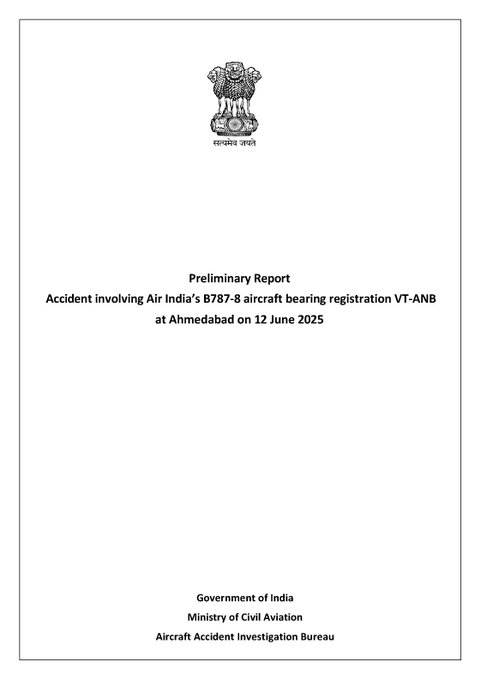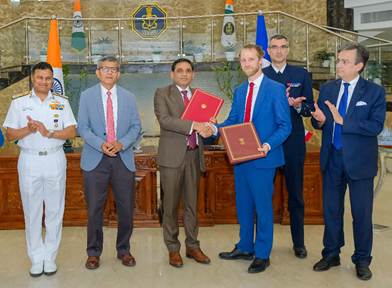engine fuel supply was cut just before Air India jet crash, preliminary report says
The Aircraft Accident Investigation Bureau (AAIB) has released its 15-page preliminary report on the Air India crash that took place in Ahmedabad on June 12. The investigation team will review additional evidence being sought from stakeholders, the AAIB said in its preliminary report.
Preliminary Report: Accident involving Air India’s B787-8 aircraft bearing registration VT-ANB
at Ahmedabad on 12 June 2025
FOREWORD
This document has been prepared based on the preliminary facts and
evidence collected during the investigation. The information is preliminary
and subject to change
In accordance with Annex 13 to the Convention on International Civil
Aviation Organization (ICAO) and Rule 3 of Aircraft (Investigation of
Accidents and Incidents), Rules 2017, the sole objective of the investigation
of an Accident/Incident shall be the prevention of accidents and incidents
and not to apportion blame or liability. The investigation conducted in
accordance with the provisions of the above said rules shall be separate from
any judicial or administrative proceedings to apportion blame or liability.
Consequently, the use of this report for any purpose other than for the
prevention of future accidents or incidents could lead to erroneous
interpretations.
3
Contents
1. General Information ……………………………………………………………………………………………………………………4
2. Background………………………………………………………………………………………………………………………………..4
3. Injuries to persons ………………………………………………………………………………………………………………………5
4. Aircraft Information…………………………………………………………………………………………………………………….5
5. Damages……………………………………………………………………………………………………………………………………6
6. Wreckage and Impact ………………………………………………………………………………………………………………….7
7. Personnel Information ……………………………………………………………………………………………………………….11
8. Meteorological Information:……………………………………………………………………………………………………….11
9. Aerodrome ………………………………………………………………………………………………………………………………11
10. Communications……………………………………………………………………………………………………………………..12
11. Flight Recorders………………………………………………………………………………………………………………………12
12. Accident Flight………………………………………………………………………………………………………………………..13
13. Progress of Investigation…………………………………………………………………………………………………………..15
4
1. General Information
1. Aircraft Type Boeing 787-8
Nationality Indian
Registration VT-ANB
2. Owner and Operator Air India
3. Pilot ATPL Holder
Extent of Injuries Fatal
4. Co Pilot CPL Holder
Extent of Injuries Fatal
5. No. of Persons on board 230 passengers, 10 Cabin Crew and 02 Flight
Crew
6. Date & Time of Accident 12 June 2025, 0809 UTC (13:39 IST)
7. Place of Accident Ahmedabad
8. Co-ordinates of Accident Site 23°03’17.8″N 72°36’43.6″E
9. Last point of Departure Sardar Vallabhbhai Patel International Airport
(VAAH)
10. Intended landing place London Gatwick Airport (EGKK)
11. Type of Operation Scheduled Passenger
12. Phase of operation Initial Climb
2. Background
On 12 June 2025, AAIB was notified of an accident involving Air India’s B787 aircraft bearing
registration VT-ANB at Ahmedabad. As per the notification, the aircraft was operating Flight
AI171 from Ahmedabad to Gatwick and crashed at about 0809 UTC immediately after takeoff. The notification was received from the Airport Authority of India and the Airline Operator.
On receipt of the notification, a team of five officers from AAIB including DG, AAIB reached
Ahmedabad on the same day. Another three officers from DGCA’s Air Safety Directorate
arrived from Mumbai to assist in the accident site activities and were put up at disposal of the
DG, AAIB. The efforts at the site were led by the DG, AAIB and evidence collection and other
site activities were carried out.
The Initial notification of the accident as per ICAO Annex 13 was sent to National
Transportation Safety Board (NTSB), USA which represented the State of Design &
Manufacture. As per the information notified to AAIB, the fatalities amongst passengers also
included citizens from United Kingdom, Portugal and Canada. The initial notification of the
accident as per ICAO Annex 13 was also sent the AAIB-UK, GPIAAF-Portugal and
Transportation Safety Board (TSB)-Canada which represented the other States whose
citizens suffered fatalities in the accident.
NTSB, USA appointed an Accredited Representative and Technical Advisers from Boeing,
GE and the Federal Aviation Administration (FAA) to assist in this Investigation. A team led
by the NTSB Accredited Representative comprising of representatives from Boeing, GE and
FAA arrived at Ahmedabad on 15.06.2025 and participated in the Investigation. A team of
officials from AAIB, UK also arrived at Ahmedabad and visited the site with DG, AAIB.
The DG-AAIB, in excise of power conferred to him by the Rule 11 (1) of the Aircraft
(Investigation of Accidents and Incidents) Rules 2017, appointed Investigation team
5
comprising Mr. Sanjay Kumar Singh as Investigator-in-Charge, Mr. Jasbir Singh Larhga as
Chief Investigator and, Mr. Vipin Venu Varakoth, Mr. Veeraragavan K and Mr. Vaishnav
Vijayakumar as Investigators.
Experienced Pilots, Engineers, Aviation Medicine Specialist, Aviation Psychologist and Flight
Recorder Specialists have been taken on board as Subject Matter Experts (SMEs) to assist
the Investigation in the area of their domain expertise.
3. Injuries to persons
Injuries Crew Passengers Others
Fatal 12 229 19
Serious NIL 1
67
Minor/None NIL NIL
4. Aircraft Information
Aircraft Model Boeing 787-8
Aircraft Sr. No. 36279
Year of Manufacturer of Aircraft 2013
Name of Owner Air India Limited
Certificate of Registration 4475/4
Certificate of Airworthiness 6584 valid subject to the validity of Airworthiness
Review Certificate (ARC)
Last ARC issued on 22 May 2025
ARC valid up to 23 May 2026
Category Normal (Passenger/Mail/Goods)
Total Aircraft Hours 41868
Engine Type Left Hand (LH) GEnx-1B70/75/P2
Date of Manufacture of Engine (LH) 20 May 2012
Engine Sl. No. (LH) 956174
Total Engine Hours/Cycles (LH) 27791:43/4298
Engine Type Right Hand (RH) GEnx-1B70/P2
Date of Manufacture of Engine (RH) 21 Jan 2013
RH Engine Sl. No. (RH) 956235
Total Engine Hours / Cycles (RH) 33439:30/ 6202
The last major line maintenance check as per the Aircraft Maintenance Program was L1-1
and L1-2 check carried out at 38504:12 Hrs and 7255 cycles. The next major check (D Check)
was due on the aircraft in Dec 2025.
The LH Engine with ESN956174 was installed on 01 May 2025 and the RH Engine with
ESN956235 was installed on the aircraft on 26 Mar 2025.
There were four CAT ‘C’ Minimum Equipment List (MEL) items active on aircraft as of
12.06.2025. These MELs were invoked on 09.06.2025 and validity of these MEL were till
6
19.06.2025. These MEL were for flight deck door visual surveillance, airport map function,
core network, FD printer.
There was a CAT A MEL active w.r.t. Nitrogen generation performance, which was valid till
20.06.2025. There were other Category D MELs/NEFs on the aircraft related to cabin and
cargo, the validity of these MELs were also within the due date.
All applicable Airworthiness Directives and Alert Service Bulletins were complied on the
aircraft as well as engines.
The FAA issued Special Airworthiness Information Bulletin (SAIB) No. NM-18-33 on
December 17, 2018, regarding the potential disengagement of the fuel control switch locking
feature. This SAIB was issued based on reports from operators of Model 737 airplanes that
the fuel control switches were installed with the locking feature disengaged. The airworthiness
concern was not considered an unsafe condition that would warrant airworthiness directive
(AD) by the FAA. The fuel control switch design, including the locking feature, is similar on
various Boeing airplane models including part number 4TL837-3D which is fitted in B787-8
aircraft VT-ANB. As per the information from Air India, the suggested inspections were not
carried out as the SAIB was advisory and not mandatory. The scrutiny of maintenance records
revealed that the throttle control module was replaced on VT-ANB in 2019 and 2023.
However, the reason for the replacement was not linked to the fuel control switch. There has
been no defect reported pertaining to the fuel control switch since 2023 on VT-ANB.
5. Damages
The Aircraft was destroyed due to impact with the buildings on the ground and subsequent
fire. A total of five buildings shown in the figure below were impacted and suffered major
structural and fire damages.
Figure 1 Accident Site with respect to airport (left) and debris field
7
6. Wreckage and Impact
After takeoff, the aircraft impacted the BJ Medical College hostel which is 0.9 NM from the
departure end of Runway 23. The Emergency Locator Transmitter (ELT) was not activated
during this event. The wreckage, from the first impact point till the last identified aircraft item,
was distributed in an area of approx. 1000 ft * 400 ft. A layout of the crash site has been given
in Fig. 2 indicating the significant parts of the aircraft. The buildings at the wreckage site have
been labelled alphabetically from A-F in the layout for easy reference.
Figure 2 Wreckage layout
8
As the aircraft was losing altitude, it initially made contact with a series of trees and an
incineration chimney inside the Army Medical Corps compound before impacting the
northeast wall of the Building A. The distance between the tree on which the aircraft made its
initial contact and the point on the Building A where the aircraft impacted is 293 ft. As the
aircraft moved forward, it continued fragmenting and collided with other structures and
vegetation. The impact witness marks on the building and airplane indicated a likely nose-up
attitude (about 8°) and wings level.
The vertical stabilizer (fig. 5) separated from the aft
fuselage and came to rest about 200 feet south of the
initial point of contact with the Building A. The tail
section and the RH Main Landing Gear (MLG) of the
aircraft were found embedded in the northeast wall of
the Building A while the rest of the airplane continued
its forward movement.
Figure 4 Tail section & RH MLG embedded in the
building A
Figure 5 Vertical Stabilizer adjacent to Building A
Figure 3 Aircraft attitude at the time of impact with Building A
8
o
9
As the airplane continued its path
across the roof of the Building A the
right engine (fig. 6) struck the
concrete water tank structure,
separated from the airplane and
rested underneath the water tank
structure facing a heading of
approx. 226 degrees near southwest wall of the Building A.
The inboard parts of the right wing
were found in Buildings A & B and
the areas surrounding the buildings. The right-wing mid-section and the outboard section
(fig.7) was about 280 feet and 520 feet southwest
respectively from the initial point of contact with the
Building A.
The left main landing gear (LH MLG) and left wing
outboard and middle section struck building C, came
to rest approx. 345 feet south from the initial point of
contact. (fig. 8). The left wing middle section of the
wing was stuck in the north corner of the fourth floor of
the Building C while the left wing inboard section was
lying about 670 feet southwest of the initial point of
contact with the Building A. (fig. 8).
The nose landing gear (NLG) (fig. 9) was found on the
ground about 307 feet southwest from the initial point
of contact with Building A.
The left engine (fig.8) got separated from the airplane
and struck the north corner of Building D at the ground
level where it remained and was roughly perpendicular
to the right engine resting position, at heading of
approx. 326 degrees. The wall was pushed into the
building and the northwest building column was damaged such that portions of the concrete
Figure 6 RH Engine
Figure 7 : RH Wing Outboard
Figure 8 LH Engine Figure 9 Nose Landing Gear
10
were missing and exposing the internal metal
rebar. The engine, remaining portions of attached
cowling, and the surrounding area were heavily
damaged by fire.
After the tail section was brought down, the APU
was inspected and found intact inside the APU
compartment. The APU air inlet door (fig. 10),
which was intact, was found open. The fuselage
fragmented and sustained thermal damage as it traveled along the northwest faces of
Buildings C, D, E, and F with the furthest debris observed at about 765 feet southwest from
the initial point of contact with building A. The flight deck area and windshield support structure
came to rest at about 650 feet southwest from the initial point of contact with Building A.
The flap handle assembly (fig.11) sustained significant thermal damage. The handle was
found to be firmly seated in the 5-degree flap position, consistent with a normal takeoff flap
setting. The position was also confirmed from the EAFR data. The landing gear lever was in
“DOWN” position. (fig.12)
The thrust lever quadrant sustained significant thermal damage. Both thrust levers were found
near the aft (idle) position. However, the EAFR data revealed that the thrust levers remained
forward (takeoff thrust) until the impact. Both fuel control switch were found in the “RUN”
position. (fig.13) The reverser levers were bent but were in the “stowed” position. The wiring
from the TO/GA switches and autothrottle disconnect switches were visible, but heavily
damaged.
Figure 13 Thrust Lever Quadrant & Fuel Control Switch
Figure 11 Flap Handle Lever Figure 12 Landing Gear Lever Module
Figure 10 APU Air Inlet Door
11
7. Personnel Information
Age/Gender 56/ Male 32/Male
License ATPL License holder CPL License holder
Date of Issue of License 14-May-2021 26-Sept-2020
Validity of License 14-May-2026 26-Sept-2025
Type Endorsements PIC: TB 20, BE,
C152, A310, B787,
B777
PIC: C172, PA-34
Co-Pilot: A320,
B787
Date of Class I Medical Exam 05 Sept 2024 04 Feb 2025
Total Flying Experience 15638:22 Hrs 3403:12 Hrs.
Total Flying Experience on Type 8596:43 Hrs 1128:14 Hrs
Total Flying Experience as PIC on Type 8260:43 Hrs 0 Hrs
Total Flying Experience during last 180 days 262:58 Hrs 233:07 Hrs
Total Flying Experience during last 30 days 56:58 Hrs 66:24 Hrs
Total Flying Experience during last 07 days 07:12 Hrs 06:10 Hrs
Total Flying Experience during last 24 hours 00:00 Hrs 00:00 Hrs
8. Meteorological Information:
The weather as per the Meteorological office at SVPI Airport, Ahmedabad at the time of the
accident was as follows:
9. Aerodrome
Sardar Vallabhbhai Patel International Airport, Ahmedabad is a DGCA licensed airport having
a license valid up to 09/06/2028. The ARFF category at the airport as per the AIP is Category
9. The runway details are as below:
Runway
Orientation
Length
(m)
Width
(m)
Surface
Type
Strength Remarks
05-23 3505 45 Asphalt 100/F/B/W/T RWY 05 – Non precision
approach
RWY 23 – ILS CAT-1
Time
(UTC)
Wind
(degre
es/Kts)
Visibility
(m) Wx
Cloud Temp
(°C)
QNH
(hPa)
Trend
0730 240/06 6000 – NSC 36 1001 Not Significant
0800 250/07 6000 – NSC 37 1001 Not Significant
0830 240/03 6000 – NSC 37 1000 Not Significant
0900 260/06 6000 – NSC 38 0999 Not Significant
12
10. Communications
After the accident the ATC data was preserved. The replay of ATC recordings data was
conducted. Summary of events based on the replay is as below:
Time (in UTC) Event
07:43:00 The aircraft requested pushback and startup.
07:43:13 ATC approved pushback.
07:46:59 ATC approved Start up.
07:49:12 ATC queried if the aircraft required full length of the runway. The aircraft
confirmed requirement of full length of RUNWAY 23.
07:55:15 The aircraft requested taxi clearance, which was granted by ATC.
08:02:03 The aircraft was transferred from Ground to Tower Control.
08:03:45 The aircraft was instructed to line up on the Runway 23.
08:07:33 The aircraft was cleared for Take-Off from Runway 23, Wind 240°/06 Kts.
08:09:05 MAYDAY call was made by AI171.
11. Flight Recorders
The aircraft is equipped with two Enhanced Airborne Flight Recorders (EAFR) part number
866-0084-102. The EAFR are fitted at two locations, one in the tail section at STA 1847 and
other in the forward section at STA 335. The two EAFRs are similar in construction and record
a combined data stream of digital flight data and cockpit voice information, with both stored
on the same device.
The aft EAFR receives electrical power from the aircraft’s main electrical system. The forward
EAFR contains an additional power source from the Recorder Independent Power Supply
(RIPS), a system that provides electrical power to the forward EAFR in the event of a power
or bus loss on the aircraft. This allows the forward EAFR to continue to record available digital
flight data, and voice data from the Cockpit Area Microphone (CAM), even after power is lost
to other aircraft systems.
The aft EAFR was located on the r
oof top of Building A on 13th June 2025. The EAFR had
impact and thermal damages to the housing. The wires were protruding from the housing and
the connectors were burnt.
The forward EAFR was located on 16th June 2025 from the wreckage debris besides the
Building F. The EAFR was burnt and covered in soot. The EAFR was still attached to the
Figure 14 EAFR AFT & FWD
13
equipment shelf with part of the connector melted but still connected. The ULB was still
connected to the housing and the lithium battery was also attached to the equipment shelf,
which was removed later prior to transportation.
Both EAFRs were transported from Ahmedabad to AAIB’s facility at New Delhi on 24th June
2025. Like various other cases where the data from damaged flight recorders was
downloaded by AAIB after sourcing ‘Golden Chassis’ and relevant download cables from the
DGCA and other Accident Investigation Authorities, in this case the ‘Golden Chassis’
(Identical EAFR unit) and Download cables required to download data from EAFR were
sourced from NTSB, USA. The items arrived on 23rd June 2025.
The download from the FWD EAFR was attempted at the AAIB Lab on 24th June 2025. The
CPM was retrieved from the EAFR and found to be in good condition. The CPM was mounted
on the Golden Chassis and the raw data was downloaded from the EAFR.
The downloaded flight data contained approximately 49 hours of flight data and 6 flights,
including the event flight. The recovered audio was two hours in length and captured the
event. Initial Analysis of the recorded audio and flight data has been done.
The aft EAFR was substantially damaged and could not be downloaded through conventional
means. The CPM was opened to inspect the memory card. The damage was extensive.
12. Accident Flight
On 12th June 2025, Air India’s B787-8 aircraft bearing registration VT-ANB arrived at
Ahmedabad airport operating flight AI423 from Delhi. The aircraft touched down at 05:47 UTC
(11:17 IST) and was parked at the bay 34.
The crew of the previous flight (AI423) had made Pilot Defect Report (PDR) entry for status
message “STAB POS XDCR” in the Tech Log. The troubleshooting was carried out as per
FIM by Air India’s on duty AME, and the aircraft was released for flight at 0640 UTC.
The aircraft was scheduled to operate flight AI171 from Ahmedabad to Gatwick with ETD
07:40 UTC (13:10 IST). The flight was to be operated by the flight crew comprising an ATPL
holder PIC, a CPL holder Co-pilot along with ten cabin crew. Both pilots were based at Mumbai
and had arrived at Ahmedabad on the previous day. They had adequate rest period prior to
operating the said flight. The co-pilot was Pilot Flying (PF), and the PIC was Pilot Monitoring
(PM) for the flight.
The crew of flight AI171 arrived
at the airport and underwent preflight Breath Analyzer test at
06:25 UTC and were found fit to operate the flight. The crew is seen arriving at the boarding
gate in the CCTV recording at about 07:05 UTC (12:35 IST).
There were 230 passengers on board, out of which 15 passengers were in business class
and 215 passengers were in economy class including two infants.
Fuel on board was 54,200 Kgs and as per the load and trim sheet of the flight, the Take-off
Weight was 2,13,401 Kgs (Max. allowed – 2,18,183 Kgs). The take-off weight was within
allowable limits for the given conditions. There was no ‘Dangerous Goods’ on the aircraft.
14
The calculated V speeds with available conditions at Take-Off were V1 – 153 Kts, Vr – 155 Kts,
V2 -162 Kts.
The A-SMGCS replay of the flight was also carried out after the accident. The aircraft was
observed departing from the bay 34 at 07:48:38UTC. The taxi clearance was received at
07:55:15 UTC and the aircraft taxied from the bay at 07:56:08 UTC. The aircraft taxied to
Runway 23 via Taxiway R4, backtracked and lined up. The take-off clearance was issued at
08:07:33 UTC. The aircraft started rolling at 08:07:37 UTC.
As per the EAFR data, the aircraft crossed the take-off decision speed V1 and achieved 153
kts IAS at 08:08:33 UTC. The Vr speed (155 kts) was achieved as per the EAFR at 08:08:35
UTC. The aircraft air/ground sensors transitioned to air mode, consistent with liftoff at 08:08:39
UTC.
The aircraft achieved the maximum recorded airspeed of 180 Knots IAS at about 08:08:42
UTC and immediately thereafter, the Engine 1 and Engine 2 fuel cutoff switches transitioned
from RUN to CUTOFF position one after another with a time gap of 01 sec. The Engine N1
and N2 began to decrease from their take-off values as the fuel supply to the engines was cut
off.
In the cockpit voice recording, one of the pilots is heard asking the other why did he cutoff.
The other pilot responded that he did not do so.
The CCTV footage obtained from the airport showed Ram Air Turbine (RAT) getting deployed
during the initial climb immediately after lift-off (fig. 15). No significant bird activity is observed
in the vicinity of the flight path. The aircraft started to lose altitude before crossing the airport
perimeter wall.
Figure 15 CCTV screenshot of RAT Deployment
As per the EAFR data both engines N2 values passed below minimum idle speed, and the
RAT hydraulic pump began supplying hydraulic power at about 08:08:47 UTC.
RAT in extended position
15
As per the EAFR, the Engine 1 fuel cutoff switch transitioned from CUTOFF to RUN at about
08:08:52 UTC. The APU Inlet Door began opening at about 08:08:54 UTC, consistent with
the APU Auto Start logic. Thereafter at 08:08:56 UTC the Engine 2 fuel cutoff switch also
transitions from CUTOFF to RUN. When fuel control switches are moved from CUTOFF to
RUN while the aircraft is inflight, each engines full authority dual engine control (FADEC)
automatically manages a relight and thrust recovery sequence of ignition and fuel introduction.
The EGT was observed to be rising for both engines indicating relight. Engine 1’s core
deceleration stopped, reversed and started to progress to recovery. Engine 2 was able to
relight but could not arrest core speed deceleration and re-introduced fuel repeatedly to
increase core speed acceleration and recovery. The EAFR recording stopped at 08:09:11
UTC
At about 08:09:05 UTC, one of the pilots transmitted “MAYDAY MAYDAY MAYDAY”. The
ATCO enquired about the call sign. ATCO did not get any response but observed the aircraft
crashing outside the airport boundary and activated the emergency response.
At 08:14:44 UTC, Crash Fire Tender left the airport premises for Rescue and firefighting. They
were joined by Fire and Rescue services of Local Administration.
13. Progress of Investigation
➢ The wreckage site activities including Drone photography/videography have been
completed, and the wreckage has been moved to a secure area near the airport.
➢ Both Engines were retrieved from the wreckage site and quarantined at a hangar in
the airport.
➢ Components of interest for further examinations have been identified and quarantined.
➢ Fuel samples taken from the bowsers and tanks used to refuel the aircraft were tested
at the DGCA’s Lab and found satisfactory.
➢ Very limited amount of fuel samples could be retrieved from the APU filter and
Refuel/Jettison valve of left wing. The testing of these samples will be done at a suitable facility
capable of carrying out the test with the limited available quantity.
➢ The EAFR data downloaded from forward EAFR is being analyzed in detail.
➢ The statement of the witnesses and the surviving passenger have been obtained by
the Investigators.
➢ Complete analysis of postmortem reports of the crew and the passengers is being
undertaken to corroborate aeromedical findings with the engineering appreciation.
➢ Additional details are being gathered based on the initial leads.
➢ At this stage of investigation, there are no recommended actions to B787-8 and/or GE
GEnx-1B engine operators and manufacturers.
➢ Investigation is continuing and the investigation team will review and examine
additional evidence, records and information that is being sought from the stakeholders.
END OF REPORT








